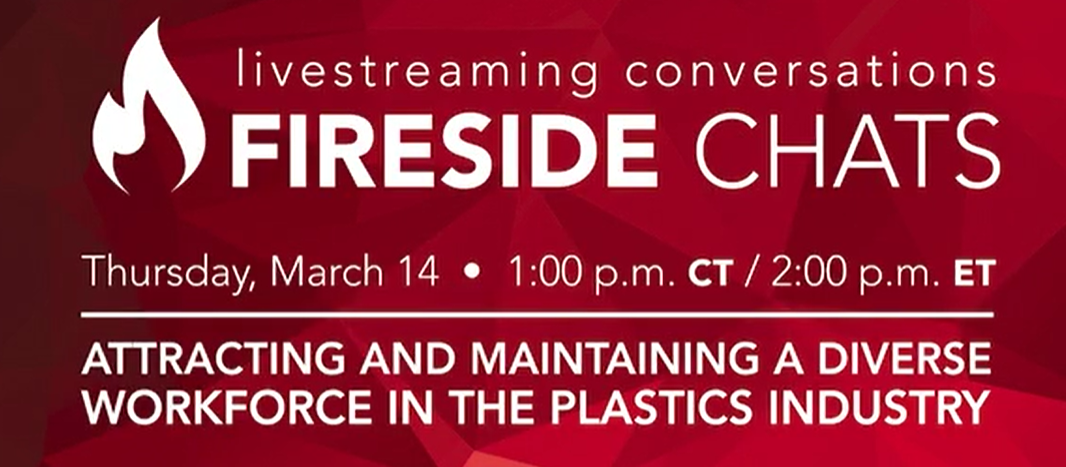Fireside Chat: How to Attract and Maintain a Diverse Workforce in the Plastics Industry
The growing talent shortage facing the plastics industry was the chosen topic for the first M. Holland Fireside Chat of 2019. The panel, which included human resources and talent acquisition technology experts, gave context behind the workforce issue, defined key generational challenges, and outlined best practices for talent recruitment and retention.
How We Got Here
During the 1980s and 1990s, U.S. manufacturing, including the plastics industry, experienced a huge exodus of business and jobs overseas. Career opportunities were limited and young people looked to more attractive areas, such as Silicon Valley and investment banking. With limited need for new talent, plastics companies scaled back their recruiting and training budgets.
Now, with the North American plastics industry experiencing a renaissance, it faces a significant talent shortage. Today, the average age of the plastics workforce is over 46, which is among the oldest among all manufacturing sectors. And while the industry has stepped up its recruitment efforts, there is a talent gap between long-time plastics workers, many of whom are approaching retirement, and the influx of young talent entering the industry. Attracting new talent in a tight labor market and balancing the needs and interests of this “bar belled” workforce is a challenge for H.R. professionals.
Defining Generational Challenges
The panelists discussed many challenges associated with filling the industry’s talent gap. And, not surprisingly, reaching younger generations was top of mind. Millennials often don’t realize the opportunities that lie in a plastics career or that they can apply a wide range of skill sets across multiple specialty areas. These specialty areas include everything from chemical engineering to sales and marketing to operations and administration.
“College students don’t recognize that they can work on interesting projects and build exciting careers in industries outside of technology,” said Jeffrey Moss, founder and CEO at Parker Dewey. “This is a challenge that manufacturing and the larger industrial sector are facing because they have interesting careers that students just aren’t aware of.” Moss recommended that plastics companies highlight their focus on innovation and technology like 3D printing. He also suggested offering exploratory internships that allow students to work with next-generation technologies.
Cindy Fisher, director of talent management and organizational effectiveness at Eaton Corporation, suggested that the industry also suffers from the risk of hyper-focusing on technical skills and education. This can cause companies to overlook younger, untapped talent. According to Fisher, companies shouldn’t assume a candidate’s skill set equals a good hire. Rather, focusing on soft skills and a candidate’s ability to learn new skills can be a better indicator of career trajectory.
Attracting younger talent is crucial to the longevity of the plastics industry but companies are struggling to create cultures that attract a multigenerational workforce. For example, younger employees may care more about community involvement and sustainability initiatives. Meanwhile, tenured employees may care more about retirement security.
Donna Sinnery, chief human resources officer at Teknor Apex, explained, “the solution lies in understanding your work population and caring about them in a way that isn’t just for today or the bottom line.” Sinnery encouraged companies to create inclusive engagement programs that address unique generational needs.
Best Practices: Talent Recruitment and Retention
Attracting new employees while retaining an existing multigenerational workforce is difficult. This is true for any company, not just those in the plastics industry. The panel agreed that there is no defined prescription for overcoming this obstacle. But, they did recommend a few best practices that have worked well for their companies.
- Enrich and sell your culture: Be deliberate and intentional about creating your company culture. Grow it, know it, understand it, and emphasize it when you’re working to attract new talent. Authentic culture is vital for turning new employees into long-term ones.
- Offer and promote diversity programs: Establish employee resource groups (ERGs). These employee-run programs bring together people who experience similar cultures, backgrounds, experiences, and more across a single organization. ERGs go a long way in celebrating diversity and making employees feel included and engaged.
- Create continuing education opportunities: It is every company’s responsibility to develop and grow their talent. Greg Watkins, talent acquisition manager at M. Holland Company, said, “it’s incumbent on us to leverage the talent we have in our company to teach incoming and existing employees…we should use the tremendous intellectual property we have access to across our management and leadership teams to allow for continued education and knowledge sharing.”
The overriding message of the Fireside Chat was that talent acquisition and management is a growing priority for the plastics industry, and companies must employ progressive new approaches in order to maintain a vibrant and stable workforce.
Please submit the form below to gain access to the webinar recording.

If you enjoyed this article, please check out some additional posts:
M. Holland Once Again Named Among Best Places To Work
Encyclopedia Brown And The Case Of The Missing Prop 65 Statement
2019 International Women’s Day: Shining A Light On The Women Of M. Holland
Exciting Changes Ahead For M. Holland’s Wire And Cable Group
Upcoming Fireside Chat: Attracting And Maintaining A Diverse Workforce In The Plastics Industry
2019 Market Trends Series: Rotational Molding And Color & Compounding
2019 Market Trends Series: Urban Expansion And New Technologies Helping Expand The Wire & Cable Market
2019 Market Trends Series: Consumer Demands Driving Growth And Change For Film & Flexible Packaging
2019 Market Trends Series: Another Transformational Year For The Automotive Market
2019 Market Trends Series: Healthcare Faces Supply Chain And Tech Disruption
2019 Market Trends Series: What’s Next For Plastics?
Tracy Coifman Joins Hundreds in Puerto Rico for Beachfront Cleanup
Cultivating The Future Of Plastics Professionals